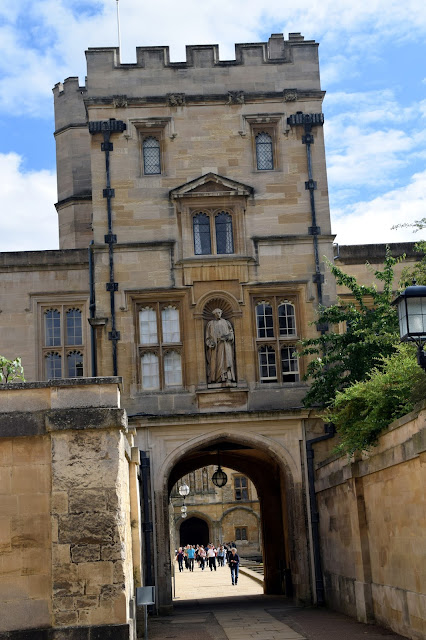By the cathedral’s main entrance from Tom Quad are a set of war memorials listing those members of Christ Church (both staff and students) who lost their lives in the two World Wars. The cathedral is in the process of creating a database of biographies for those featured on the walls.
On passing the memorial into the cathedral, visitors will see the organ rising above them. Although the present organ was only installed in 1979, the first music master of the college to play in the church was the celebrated sixteenth-century composer, John Taverner. Taverner was perhaps England’s finest composer of the period and the bulk of his output - mostly religious works - is thought to stem from the 1520s, part of which he spent as master of the choristers of the choir of Cardinal College. The tradition of musical excellence continues, and the world famous choir sings the cathedral services on most days during term.
To the left of the organ is one of the college’s most precious glass windows. Following the appointment of Archbishop Laud as Chancellor of the University in 1630, a series of windows were commissioned from the Flemish brothers, Abraham and Bernard van Linge, to add beauty and colour to the cathedral. However, only the Jonah Window (the window just to the left of the organ) and three others survived the Civil War. Such items were extremely controversial in their day, as many believed that such images were idolatrous distractions from true worship. Indeed, most of the van Linge windows were broken up by a canon’s boot heels in 1651, a little after the Parliamentarian victory in the civil wars. The shards were recently rediscovered and some were displayed in a 2013 Tate Britain exhibition on iconoclasm.
Passing down the aisle to the far corner of the cathedral (known as the Latin Chapel) brings you to the reconstructed shrine to St Frideswide. The shrine was installed in the church in 1289 but broken up in 1538 during the Reformation when devotion to saints was heavily criticised. Parts of the shrine were found in a well in the nineteenth century and restored to the church, a second reconstruction was then made in 2002. It stands as a memorial to the courage of St Frideswide and all like her, and reminds us that this site has been attracting visitors ever since Saxon times. Above the shrine is a beautiful coloured window by the Pre-Raphaelite artist Edward Burne-Jones, depicting the life of the saint a and dating from 1858. In one striking panel, the miraculous lightning bolt blinds king Algar who had pursued Frideswide to the sanctuary. And, in the bottom right corner, Burne-Jones included a modern day flushing toilet, supposedly as an acknowledgement of the company which helped finance the window’s creation.
On a pillar between the Latin Chapel and the Lady Chapel is a memorial to Robert Burton, the famous writer and college librarian. Burton is remembered chiefly for his work on ‘melancholy’, pioneering in its day for its discussion of mental health. But Burton’s place in the cathedral was not as secure as it may at first seem. There was a rumour that Burton hanged himself in order to conform to his own astrological calculations about his date of death. Perhaps a fitting end given his lifetime preoccupation with melancholy, but ill-supported by evidence: had it been true it is unlikely that he would have been buried in the cathedral, as suicide was viewed as a sin by Christians in seventeenth-century England.
The cathedral also contains memorials to the men and women who have shaped its history in more recent times, especially during the two World Wars of the twentieth century. To the left of the main altar is the Bell Altar, in honour of the Bishop George Bell, who opposed the bombing of German civilians in the Second World War. On the other side of the Chancel lies the Chapel of Remembrance, dedicated to the servicemen and women who gave their lives in the struggles of the period. That Chapel also features another stained glass window by Edward Burne-Jones, a depiction of St Catherine modelled on the then dean’s daughter, Edith Liddell. Edith’s sister Alice, would prove to be the inspiration for Charles Dodgson’s work Alice in Wonderland.
[ http://www.chch.ox.ac.uk/visiting-christ-church/cathedral]













No comments:
Post a Comment